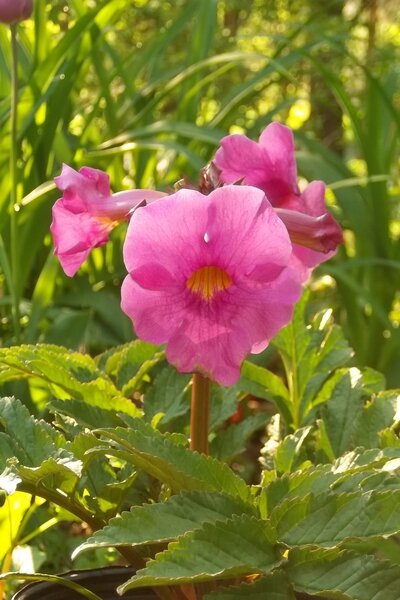Is hardy gloxinia making a comeback?
Loading...
Here in northwestern New Jersey, where temperatures are still dropping into the 40s at night, there's no holding back for gardeners. Common sense has nothing to do with how early we purchase our annuals and tender perennials.
Recently, I made a quick stop at a local garden center "just to look around," and bought a plant I didn't know existed – hardy gloxinia (Incarvillea delavayi).
A quick search on the internet revealed that this is not a new introduction, but rather a plant native to the Orient that was sent to Europe in the mid-1800s. It is named for two Jesuit missionaries/plant explorers to China, Pierre Nicolas Le Cheron d'Incarville and Jean Maries Delavay.
Everything old is new again
Hardy gloxinias were popular in older English gardens, and I can easily see why. The deeply cut fernlike foliage stands up to 24-inches tall and adds texture to the garden, even after the flowers fade.
Multiple splashy rose-purple or white blossoms with yellow throats are borne on central stems that attract hummingbirds as well as butterflies. They are related to trumpet vines and have few pest problems, except for slugs.
All that makes me question why they ever went out of favor. But maybe that's just it. Flowers and flower colors, like women's fashions, go in and out of style at the drop of a hat, no matter how well-loved they may be.
Perhaps, also like women's fashions, everything comes back again, sooner or later.
Blooms at a good time
Sources differ as to whether the plants are hardy to Zone 5 or Zone 6 (I guess I'll find that out next spring), but they require winter protection in either case.
While late to emerge, they flower from midspring to midsummer, providing color during a transition time when it can be tricky to deliver a succession of bloom. Deadheading encourages reblooming.
Some mail order nurseries sell hardy gloxinia as a bulb, although it is variously described as a fleshy tuber, or as having a taproot, so you may find it listed in either the bulb or perennial category.
It's always a delight to rediscover heirloom or heritage plants, and I'm happy to see this one poised for a comeback. Makes me wonder what else I'm missing.
For a brief history of the plant's namesakes and detailed growing advice, visit Go Garden Now.
-----
Lois de Vries, a popular speaker at regional flower shows and garden clubs, writes from her home in rural northwestern New Jersey. To read her other posts at Diggin' It, click here. She's a field editor for Better Homes and Gardens and Country Gardens magazines and has been a contributing editor for other national publications. She was awarded the Jefferson Presidential Award for public service in environmental work. Click here and here to read about her garden design and environmental ideas and her holistic approach to gardening.You can also follow her on Twitter and Facebook.






